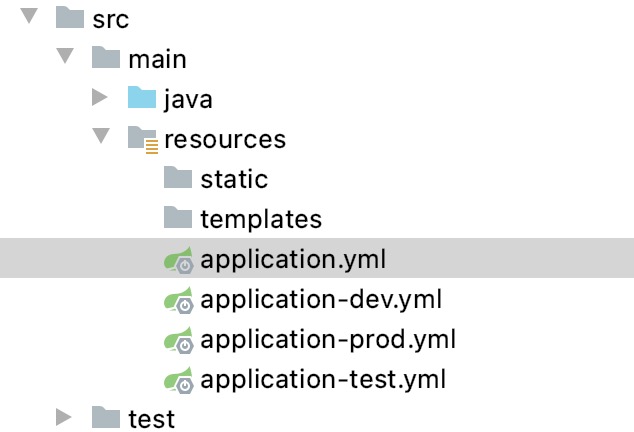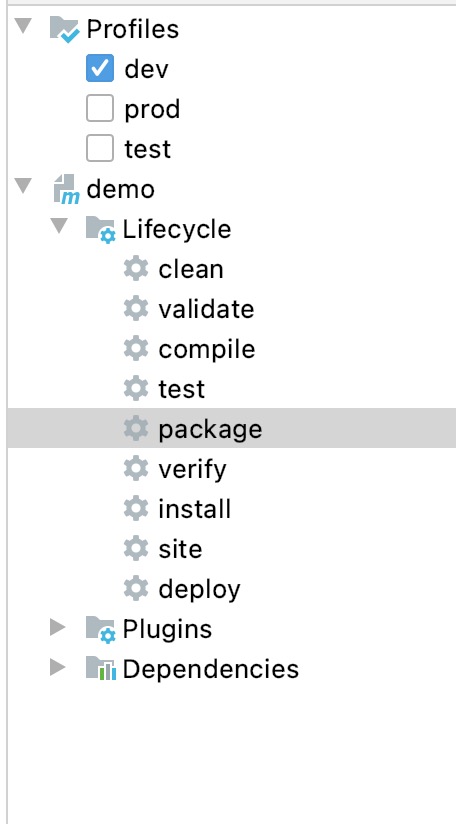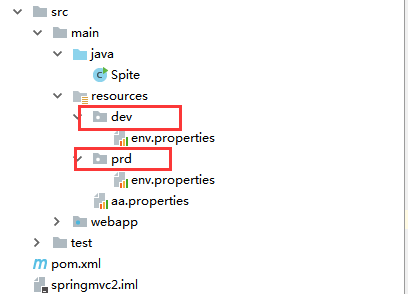maven中profiles使用详解
使用的场景
常常遇到一些项目中多环境切换的问题。比如在开发过程中用到开发环境,在测试中使用测试环境,在生产中用生产环境的情况。springboot中提供了 spring.profile.active的方式来实现多环境的切换,通过设置环境变量和启动参数的方式。但是这样做终究不能一劳永逸,要么需要修改yml文件,要么需要记得启动的时候带上参数。而利用maven的profiles,可以减少很多工作。让我们通过几个例子一步步的掌握使用maven的profiles属性。
快速上手
pom.xml文件设置
<profiles>
<profile>
<!--不同环境Profile的唯一id-->
<id>dev</id>
<properties>
<!--profiles.active是自定义的字段(名字随便起),自定义字段可以有多个-->
<profiles.active>dev</profiles.active>
</properties>
</profile>
<profile>
<id>prod</id>
<properties>
<profiles.active>prod</profiles.active>
</properties>
<activation>
<activeByDefault>true</activeByDefault>
</activation>
</profile>
<profile>
<id>test</id>
<properties>
<profiles.active>test</profiles.active>
</properties>
</profile>
</profiles>
目录结构。

application.yml
spring:
profiles:
active: @profiles.active@
application-dev.yml中代码如下
server:
port: 7091
其他几个文件我只是把端口号进行了修改,方便打包看不同的效果。
maven打包与激活profiles
你可以执行命令
mvn clean package -Ptest
然后启动jar包,可以看到jar包启动的是test的配置,如果换成-Pdev启动的就是dev包的端口。
默认启动方式
如果不带-Ptest,启动的是 prod的端口。因为在profiles中我们看到有配置默认的选项。
<activation>
<activeByDefault>true</activeByDefault>
</activation>
settings.xml中使用activeProfiles指定
<activeProfiles>
<activeProfile>profileTest1</activeProfile>
</activeProfiles>
通过IDEA的可视化的方式
当然如果使用IDEA工具进行开发,还可以使用可视化的方式进行打包。

更高级的玩法
通过和pom结合的方式设置动态参数
如果我们希望通过docker-maven-plugin插件,把编译好的jar打包成docker并且传入相应的开发、测试、生产的服务器中去。这个时候,我们就需要根据不同的条件去传入不同的服务器。
在profiles中我们可以做以下定义
<profiles>
<profile>
<id>dev</id>
<properties>
<profile.id>dev</profile.id>
<docker.host>http://dev.demo.com:2375</docker.host>
</properties>
<activation>
<activeByDefault>true</activeByDefault>
</activation>
</profile>
<profile>
<id>test</id>
<properties>
<profile.id>test</profile.id>
<docker.host>http://test.demo.com375</docker.host>
</properties>
</profile>
<profile>
<id>prod</id>
<properties>
<profile.id>prod</profile.id>
<docker.host>http://prod.demo.com:2375</docker.host>
</properties>
</profile>
</profiles>
而在build控件中我们可以使用以下配置
<build>
<plugins>
<plugin>
<groupId>com.spotify</groupId>
<artifactId>docker-maven-plugin</artifactId>
<version>1.1.0</version>
<executions>
<execution>
<id>build-image</id>
<phase>package</phase>
<goals>
<goal>build</goal>
</goals>
</execution>
</executions>
<configuration>
<imageName>demo/${project.artifactId}</imageName>
<imageTags>
<imageTag>${project.version}-${current.time}</imageTag>
<imageTag>latest</imageTag>
</imageTags>
<forceTags>true</forceTags>
<dockerHost>${docker.host}</dockerHost>
<forceTags>true</forceTags>
<baseImage>java:8</baseImage>
<entryPoint>["java", "-jar", "/${project.build.finalName}.jar"]</entryPoint>
<resources>
<resource>
<targetPath>/</targetPath>
<directory>${project.build.directory}</directory>
<include>${project.build.finalName}.jar</include>
</resource>
</resources>
</configuration>
</plugin>
</plugins>
</build>
其中 ${project.artifactId} 和${project.version}是关于节点下面和的引用。${current.time}是在build-helper-maven-plugin定义的,我们回头再研究。
${docker.host}则是我们在profiles中定义的,可以随着我们选择不同的profile,把jar包build成不同的docker镜像,并传入指定服务器。
通过和yml结合设置动态参数
除了可以在pom中设置动态参数,使得其根据profile的不同选择不同的参数。还可以通过设置不同的profile,让yml选择不同的参数。这点和快速上手的例子有点相似。具体如下:
设置profiles
<profiles>
<profile>
<id>dev</id>
<properties>
<profile.id>dev</profile.id>
<eureka.url>http://127.0.0.1:8001/eureka</eureka.url>
</properties>
<activation>
<activeByDefault>true</activeByDefault>
</activation>
</profile>
<profile>
<id>test</id>
<properties>
<profile.id>test</profile.id>
<eureka.url>http://base-registry:8001/eureka</eureka.url>
</properties>
</profile>
<profile>
<id>prod</id>
<properties>
<profile.id>prod</profile.id>
<eureka.url>http://base-registry:8001/eureka</eureka.url>
</properties>
</profile>
<profile>
<id>new</id>
<properties>
<profile.id>new</profile.id>
<eureka.url>http://base-registry:8001/eureka</eureka.url>
</properties>
</profile>
</profiles>
我们在profile中设置了一个eureka.url的属性,就可以在yml中直接调用。
eureka:
client:
service-url:
defaultZone: @eureka.url@
registry-fetch-interval-seconds: 10
instance:
prefer-ip-address: true
在IDEA调试和启动的时候,一般会报错如下:
org.yaml.snakeyaml.scanner.ScannerException: while scanning for the next token
found character ‘@’ that cannot start any token.
解决方法就是引入yaml.sankeyaml的jar包
<dependency>
<groupId>org.yaml</groupId>
<artifactId>snakeyaml</artifactId>
</dependency>
打包不同的资源
在profile打包yml文件的时候,如果我们解压了jar包,会发现还是把所有的application-profile.yml文件给打包进去了。这个可以通过设置打包参数,只打包需要的application文件。
<profiles>
<profile>
<id>dev</id>
<properties>
<env>dev</env>
</properties>
<activation>
<activeByDefault>true</activeByDefault>
</activation>
</profile>
<profile>
<id>prd</id>
<properties>
<env>prd</env>
</properties>
</profile>
</profiles>
<build>
<finalName>springmvc</finalName>
<resources>
<resource>
<directory>src/main/java</directory>
<includes>
<include>*.xml</include>
</includes>
</resource>
<resource>
<directory>src/main/resources</directory>
<excludes>
<exclude>dev/*</exclude>
<exclude>prd/*</exclude>
</excludes>
</resource>
<resource>
<directory>src/main/resources/${env}</directory>
</resource>
</resources>
</build>
目录结构如下:

maven中profiles使用详解的更多相关文章
- maven中scope标签详解
前言 最近在做itoo的pom优化工作,发现对于maven依赖管理中的scope标签还是有不明白的地方,所以今天就来总结一下这方面的知识,scope在maven的依赖管理中主要负责项目的部署 mave ...
- Maven中POM.XML详解
转自https://blog.csdn.net/jariwsz/article/details/19554137 我们先看一个简单的例子: <project xmlns="http:/ ...
- maven 中的mirror详解
一.前言 今天同事遇到个问题,本来公司是有maven私服的,但同事觉得上面有些东西下载不到,于是在自己本地的maven配置中加了: <mirrors> <mirror> < ...
- maven中的Exclusions详解
依赖关系:Project-A>Project-B>Project-C,但是Project-A不依赖Project-C,在Project-A中的POM.xml应该进行如下配置: <de ...
- Maven中的dependency详解
<dependency> <groupId>junit</groupId> <artifactId>junit</artifactId> & ...
- Maven依赖中的scope详解,在eclipse里面用maven install可以编程成功,到服务器上用命令执行报VM crash错误
Maven依赖中的scope详解 项目中用了<scope>test</scope>在eclipse里面用maven install可以编译成功,到服务器上用命令执行报VM cr ...
- Maven pom.xml文件详解
Maven pom.xml文件详解 一.简介 POM全称是Project Object Model,即项目对象模型. pom.xml是maven的项目描述文件,它类似与antx的project.xml ...
- Maven配置文件setting.xml详解
注:本文来源于:大话JAVA的那些事 <Maven配置文件setting.xml详解> <?xml version="1.0" encoding="UT ...
- oracle中imp命令详解 .
转自http://www.cnblogs.com/songdavid/articles/2435439.html oracle中imp命令详解 Oracle的导入实用程序(Import utility ...
随机推荐
- 比赛难度(HDU4546)
比赛难度 Time Limit: 3000/1000 MS (Java/Others) Memory Limit: 65535/32768 K (Java/Others)Total Submis ...
- Codeforces 913C:Party Lemonade(贪心)
C. Party Lemonade A New Year party is not a New Year party without lemonade! As usual, you are expec ...
- 主流的 API 架构
1. RPC:调用另一个系统的函数 2. SOAP:使数据作为服务可用 3. REST:使数据作为资源可用 4. GraphQL:仅请求所需要的数据 1. RPC:调用另一个系统的函数 远程过程调用是 ...
- Java基础(八)——IO流3_对象流
一.对象流 1.序列化与反序列化 序列化:将内存中的Java对象保存到磁盘中或通过网络传输出去. 反序列化:将磁盘文件中的对象还原为内存中的一个Java对象. 用途: (1)将对象保存到物理硬盘:比如 ...
- Swoole 中使用 UDP 异步服务器、UDP 同步客户端、UDP 协程客户端
UDP 异步风格服务器 # udp_server.php // 创建 UDP 服务器对象,监听0.0.0.0:9502端口,类型为SWOOLE_SOCK_UDP $serv = new Swoole\ ...
- PHP 中的多进程使用,进程通信、进程信号等详解
多进程环境要求 Linux 系统 php-cli 模式 pcntl 扩展 或 swoole 扩展 pcntl 扩展 <?php $str = "hello world!" . ...
- sqlplus -S参数表示什么意思?
sqlplus -S , -S选项是静默模式,是Silent的缩写.在这种模式下将会以最精简的形式完成SQL*Plus的交互过程. -S模式多用于脚本模式.在命令行sqlplus -S还有可能出现卡住 ...
- 利用ajaxfileupload插件异步上传文件
html代码: <input type="file" id="imgFile" name="imgFile" /> js代码: ...
- Hive分析统计离线日志信息
关注公众号:分享电脑学习回复"百度云盘" 可以免费获取所有学习文档的代码(不定期更新)云盘目录说明:tools目录是安装包res 目录是每一个课件对应的代码和资源等doc 目录是一 ...
- Mybatis-Plus的引用
一.依赖 <dependency> <groupId>com.baomidou</groupId> <artifactId>mybatis-plus-b ...
